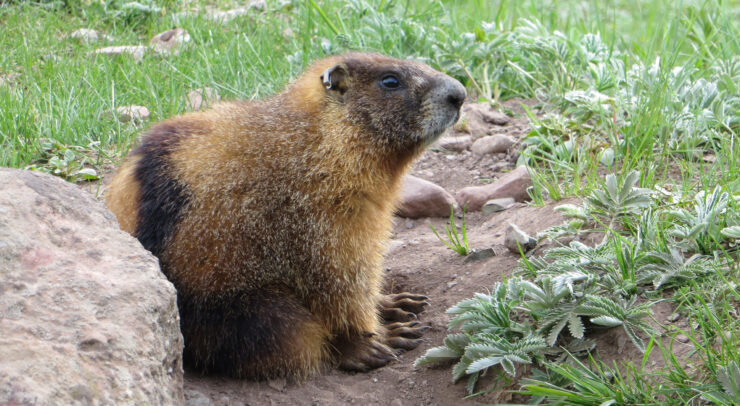DON’T SLEEP ON THIS RESEARCH
As the weather warms, the snow that once blanketed Ottawa is now beginning to melt. Among other things associated with spring, many hibernating species such as chipmunks and groundhogs will soon begin to emerge from their burrows.
Having little to no knowledge on how hibernation actually works, let alone its implications on ageing, I took this opportunity to approach Dr. Julien Martin, an evolutionary biology professor at the University of Ottawa. Martin recently published a study entitled “Hibernation slows epigenetic ageing in yellow-bellied marmots” to help explain hibernation and his research in more detail.
But first, what is hibernation?
According to Martin, hibernation refers to the behaviour seen in animals where they disappear or burrow throughout the winter months (a period of roughly eight months), known as torpor or deep top. During the remaining four months of the year the animal is active, they need to double their body mass to support themselves for the next winter season.
When animals go into hibernation, their bodies undergo a massive slowdown of the entire metabolic system. Their internal temperature drops from around 37 degrees Celsius to four or below. However, those levels of inactivity are not continuous throughout those eight months. Simply put, the physiology would be too slow and the brain would begin to accumulate damage since none of the protection mechanisms or maintenance mechanisms are being maintained.
To compensate, “every four to ten days, their body temperature rises up again, back to 37 degrees for a period of roughly 24 hours. During this active period of time, all the physiological and cellular mechanisms are completely boosted, allowing for maintenance to occur. Then they go back into torpor. This cycle in body temperature repeats throughout the period of winter,” explained Martin.
What’s the relationship between a species’ biological and epigenetic age?
Martin explained that biological ageing is the age that we measure as humans and it’s determined by your birthday. In contrast, determining your epigenetic ageing requires a closer look at the markers on your DNA that are related to age.
More specifically, those markers are the methyl groups (CH3) bound to the ribosomes of the DNA in a process known as methylation.
“So we’re going to look at the changes in modulation on the DNA in certain regions of the genome, a lot of studies have shown that those methylation groups vary with age. If you are able to measure the level of methylation on the DNA, combined with a statistical model, you could predict really well the age of an individual,” said Martin.
The hibernation-ageing hypothesis
According to Martin, the hibernation-ageing hypothesis is based on two observations. The first operates on the assumption that the rate of ageing is constant through time and is thereby not impacted by seasons, meaning that hibernation should not be linear because of the change in metabolism and physiology between the active season and the hibernation period.
Next researchers assumed that ageing during hibernation is slower rather than faster based on the fact that hibernating species live a longer lifespan compared to animals with a similar body mass. This led researchers to the idea that there’s a causal mechanism happening during hibernation which would result in faster ageing occurring at the DNA level during active periods and a plateau, or slower ageing, during the winter months.
Research Methods
Martin mentioned that one of the major benefits of his study was that they worked with one of the most complete and detailed datasets on the wild yellow bellied marmot that exists. Researchers were able to work on stored blood samples of the animals.
“We used blood samples on individuals of an exact known age, so for which we know the date of birth, all the environmental conditions, their reproductive success, and even who the parents are. From there, we’ve been able to estimate the DNA methylation or the epigenetic ageing at different ages across the life of multiple individuals,” explained Martin.
From there, researchers were able to compile data from individuals over multiple summers in a row to see how methylation is changing within a given season. With that, they used a generalized additive mixed models (GAMM) — essentially a statistical model.
He added that these models “allow us to take into account the fact that we’ve got observations on multiple individuals and to capture that kind of plateau or slowing down in ageing over the winter with the structure of the data we have.”
In summary, researchers did find support for the hibernation-ageing hypothesis, meaning that there is indeed a plateau during the winter and a linear increase in ageing over the active season, in addition to a plateau or even a decrease in epigenetic ageing during hibernation. This means that not only is epigenetic ageing slowing down, but it might even be reversing.
Moving forward, Martin stressed the importance of the impact that climate change may have on hibernating species. Oftentimes, species use hibernation to escape harsh winter environments. As the climate changes, potential warming could determine whether or not an animal hibernates, which we now understand is related to ageing. Therefore, it’s crucial to understand from an ecological perspective the significance of hibernation for the overall life history or ecology of a species.
For more information on Julien Martin and his work on how species evolve and adapt in the natural system, you can visit his website here.





